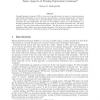NAACL
2010
13 years 10 months ago
2010
Current statistical parsers tend to perform well only on their training domain and nearby genres. While strong performance on a few related domains is sufficient for many situatio...
NAACL
2010
13 years 10 months ago
2010
This paper investigates using prosodic information in the form of ToBI break indexes for parsing spontaneous speech. We revisit two previously studied approaches, one that hurt pa...
EMNLP
2010
13 years 10 months ago
2010
It is well known that parsing accuracies drop significantly on out-of-domain data. What is less known is that some parsers suffer more from domain shifts than others. We show that...
ACL
2010
13 years 10 months ago
2010
We propose a novel self-training method for a parser which uses a lexicalised grammar and supertagger, focusing on increasing the speed of the parser rather than its accuracy. The...
TSD
2010
Springer
13 years 10 months ago
2010
Springer
Abstract. Maltparser is a contemporary dependency parsing machine learningbased system that shows great accuracy. However 90% for Labelled Attachment Score (LAS) seems to be a de f...
FUIN
2008
13 years 12 months ago
2008
Parsing Expression Grammar (PEG) is a new way to specify syntax, by means of a top-down process with limited backtracking. It can be directly transcribed into a recursive-descent ...
CORR
1999
Springer
14 years 3 days ago
1999
Springer
We propose a parser for constraintlogic grammars implementing HPSG that combines the advantages of dynamic bottom-up and advanced topdown control. The parser allows the user to ap...
CORR
1998
Springer
14 years 3 days ago
1998
Springer
This paper describes a partial parser that assigns syntactic structures to sequences of partof-speech tags. The program uses the maximum entropy parameter estimation method, which...
COLING
2002
14 years 8 days ago
2002
With the rapid growth of real world applications for NLP systems, there is a genuine demand for a general toolkit from which programmers with no linguistic knowledge can build spe...
COGSCI
2004
14 years 9 days ago
2004
Disfluencies include editing terms such as uh and um as well as repeats and revisions. Little is known about how disfluencies are processed, and there has been next to no research...






